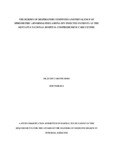| dc.contributor.author | Ooko, Juliet A | |
| dc.date.accessioned | 2018-10-17T11:49:36Z | |
| dc.date.available | 2018-10-17T11:49:36Z | |
| dc.date.issued | 2018 | |
| dc.identifier.uri | http://hdl.handle.net/11295/104082 | |
| dc.description.abstract | In recent years, attention has been drawn to the increasing prevalence of several non- infectious pulmonary complications linked to HIV infection. The prevalence and type of spirometric abnormalities, factors that alter lung function parameters and the accompanying respiratory symptoms are largely unevaluated especially in sub-Saharan Africa, which is home to two thirds of people living with HIV globally.
OBJECTIVES: This study set out to describe the burden of respiratory symptoms and to determine the prevalence and type of spirometric abnormalities among ambulatory ART- treated HIV patients on follow up at the Kenyatta National Hospital Comprehensive Care Centre (KNH-CCC).
METHODOLOGY: This was adescriptive cross sectional study carried out among ambulatory HIV infected adults on HAART on routine follow–up at the KNH Comprehensive Care Centre
DATA MANAGEMENT AND ANALYSIS: The American thoracic society – Division of lung disease (ATS-DLD) respiratory questionnaire was used to obtain demographic data and data on the respiratory symptoms. All patients underwent spirometric test as per the ATS/ERS guidelines. Data was analysed using SPSS version 21.0. Descriptive characteristics of the population were summarised as percentages for categorical data and means or medians for continuous variables. The prevalence of spirometric abnormalities and respiratory symptoms were analysed and presented as proportions with 95% confidence intervals. Pearson Chi-square test was used to check for any association between the patients’ characteristics and the presence of spirometric abnormalities and respiratory symptoms.
RESULTS: This study recruited 371 ART treated patients. The study population was largely female with a mean (SD) age of 47.4 (10.3) years. The median CD4 count and viral load were 480.2 cells/ml and 0.01 copies/ml respectively. A history of previous pulmonary tuberculosis infection was present in 31% of the participants while 15% had a previous history pneumonia. The most common respiratory symptom was cough (22.4%) followed by sputum production (18.9%), breathlessness (15%), sneezing (13.5%) wheezing (12.7%) and nasal congestion (11.6%). Restrictive spirometric abnormalities were the most frequent at 11.3% (95% CI [8.1; 14.5]) obstructive at 6.2% (95% CI [3.7; 8.7]) and mixed at 1.1% (95% CI [0.0; 2.1]). | en_US |
| dc.language.iso | en | en_US |
| dc.publisher | University of Nairobi | en_US |
| dc.title | The burden of respiratory symptoms and prevalence of spirometric abnormalities among HIV infected patients at the Kenyatta national hospital comprehensive care centre. | en_US |
| dc.type | Thesis | en_US |
| dc.description.department | a
Department of Psychiatry, University of Nairobi, ; bDepartment of Mental Health, School of Medicine,
Moi University, Eldoret, Kenya | |

